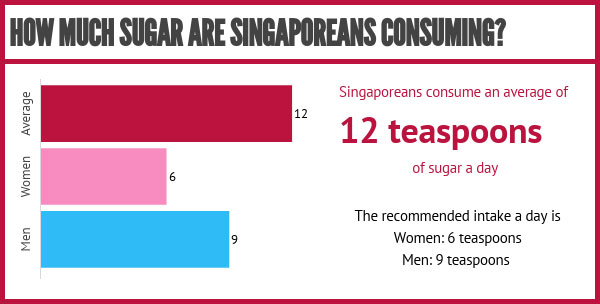Bubble tea tastes great and it’s one of the most popular beverages in Singapore – but is it actually a sweet way to ruin your health?
The key ingredient here is sugar. Many people in Singapore are having too much of it; and the ongoing bubble tea craze is a good example.
According to research commissioned by Channel NewsAsia and conducted by science and nutrition students at Temasek Polytechnic, a 500ml cup of brown sugar boba milk can contain about 92g of sugar, almost three times more than in a 320ml can of cola.
When you consider that the amount of sugar in a can of cola is considered a classic example of excess consumption of the sweet stuff, that is a shocking finding indeed.
Singapore is too sweet
So how much sugar are Singaporeans consuming? According to the Ministry of Health, Singaporeans consume on average 12 teaspoons (or 60g) of sugar daily.
This is at least three teaspoons over the limit; the American Heart Association says women should consume no more than six teaspoons of sugar a day and for men, no more than nine. So women are 50% over the limit, and men 33%.

High sugar intake is linked to increased risk of obesity and diabetes, and the Ministry of Health cites the consumption of pre-packaged sugar-sweetened beverages (SSBs) as a major reason for health concerns in Singapore.
Is it hard to kick the sugar habit?
Like anything your body becomes addicted to, getting off the sugar is not always easy.
Sugar can be as addictive as drugs and alcohol and it is very hard to avoid; it is found in so many things that we consume every day, most of the time we don’t even realise it.
Even thinking about sugar can set off cravings, because sugar stimulates the brain and releases dopamine — a neurotransmitter that controls pleasure and reward-motivated behaviour — into your system.
So what happens when you start cutting it out? According to Addiction Resource, our body actually goes through physiological changes when we cut sugar.
Our hormone levels change within hours and insulin levels decrease, and over a longer period, your palate changes so that you need a lot less sugar to feel satisfied. Your body will be able to use stored fat to burn energy, which is nice for the waistline.
That’s the good news. The bad news is, it will take time and there will be withdrawal symptoms. Sugar is a stimulant and when you take it away suddenly, you’re asking your body to adjust rapidly.
Withdrawing from sugar
Cravings
Immediately after quitting sugar, you will crave it. Your body is still dependent on it, and will demand it back.
Lethargy
You’ll feel lethargic because you’ve cut out your primary energy source: sugar. You may feel like you’re falling sick, and your mind feels dull. You may even feel a little depressed.
Anxiety
Sugar often provides a nice energy boost and makes us happy in the short term. Taking away this source makes our brains react in ways that can manifest as anxiety.
Headaches
Perhaps the most common side effect of quitting sugar is a headache. It is often recommended to consume small amounts of sugar to relieve the headaches, preferably from fruits.
Other side effects from quitting sugar cold turkey include muscle pain and aches; insomnia; chills; nausea; gas and bloating.
A sugarless life is still sweet — or sweeter
It isn’t all suffering though. Once you get through that rough detox period, you will find a range of benefits.
Getting added sugars out of your life means many good things for your body, including:
- weight loss and lowered risk of obesity
- more energy throughout the day
- clearer skin
- a calmer mind
- reduced inflammation
- reduced risk of digestive conditions
- reduced risk for type 2 diabetes
So how do you begin cutting sugar out of your diet?
- Stop adding sugar to things you eat or drink (including coffee or tea). You might need to take this slowly — start by adding half a teaspoon and work your way down.
- Stick to water. Soft drinks, ice tea, or even juice contain more sugar then you really need.
- If you’re after a sugar fix, try the natural kind found in fresh fruit. Even dried or canned fruits will work — but avoid those canned in syrup.
- When shopping, take the time to check out the ingredients list — opt for products with the lowest levels of added sugars.
- Replace sugar with fresh or dried fruit (strawberries or sultanas) in your cereal. When cooking, add extracts like almond or lemon instead of sugar.
- Don’t follow the recipe, especially when it comes to cakes and cookies. Cut the sugar added by half and see if you notice the difference.
Disclaimer:
The information in this article does not necessarily reflect the views of Prudential Assurance Company Singapore Pte. Ltd. Certain information in this article may be taken from external sources, which we consider reliable. We do not represent that this information is accurate or complete and should not be relied upon as such.
This article is for your information only and does not consider your specific investment objectives, financial situation or needs. We recommend that you seek advice from a Prudential Singapore Financial Consultant before making a commitment to purchase a policy.

